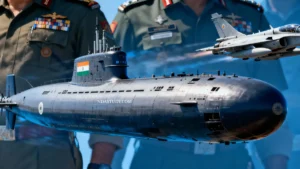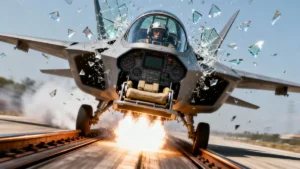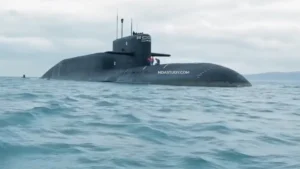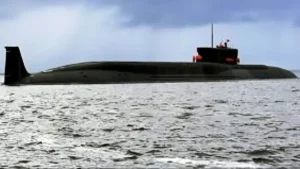HYDERABAD, November 14, 2025 — India’s Defence Research and Development Organisation (DRDO) has achieved a critical breakthrough in the K-5 submarine-launched ballistic missile program with the successful static firing of the Stage-2 rocket motor, marking a giant leap toward operationalising the nation’s undersea nuclear deterrence capability.
The test, conducted at the Armament & Combat Engineering (ACEM) facility in Hyderabad on November 11, validated the 5,000-6,000-kilometre range submarine missile’s mid-flight propulsion system, clearing the path for underwater launch trials beginning as early as 2025-2026.
K-5 SLBM Stage-2 Motor Test Succeeds
The K-5 Stage-2 motor static test deployed over 250 real-time instrumentation channels, capturing comprehensive performance data. Every single parameter—thrust output, combustion pressure, burn duration, structural loads, nozzle performance, and thermal stability—matched DRDO’s predictive ballistic models with 100% fidelity.
“This successful test removes a critical technical barrier,” said defence sources. “The Stage-2 motor is the powerhouse that determines whether K-5 achieves its 5,000+ km range. Validation means production readiness is now within sight.”
The HD 1.3 composite propellant (developed by DRDO’s High Energy Materials Research Laboratory) demonstrated consistent thrust output throughout the burn cycle—essential for maintaining accuracy at extreme ranges. The motor’s carbon-fibre composite casing withstood internal pressures exceeding 200 atmospheres without structural failure.
Why This Matters NOW
This test signals that India is rapidly moving from theoretical submarine-based deterrence to operational reality. The implications are seismic:
Completes India’s Nuclear Triad
For the first time, India possesses the technical foundation for a fully credible second-strike capability from submarines. The land-leg (Agni-5 missiles) and air-leg (fighter jets) already exist. K-5 now seals the sea-leg—the most survivable, unstoppable leg. China operates the JL-2 SLBM (7,000 km range). K-5’s 5,000-6,000 km reach establishes strategic parity for Indian Ocean operations. Future K-6 SLBM (8,000 km, under development) will exceed Chinese capabilities entirely.
India’s “no-first-use” nuclear pledge becomes genuinely credible only with hidden submarines armed with K-5 missiles. Adversaries can never eliminate India’s retaliatory capability because submarines remain invisible for months. DRDO developed this indigenous propulsion technology without foreign dependence. Russia previously supplied submarine missile expertise. Now, India controls its own strategic weapons development.
Breaking Down the K-5 Submarine Missile Specs
The K-5 SLBM embodies cutting-edge submarine weapon engineering:
| Specification | Details |
|---|---|
| Range | 5,000–6,000 km (covers all of China + Southeast Asia + Middle East from Indian Ocean) |
| Payload | 2 tonnes (modern thermonuclear warhead) |
| Length | 12 meters (compact for submarine tubes) |
| Diameter | 2.45 meters (fits Arihant-class launch canisters) |
| Stages | Three solid-fuel stages (Stage-1: underwater boost, Stage-2: mid-flight thrust, Stage-3: final push + warhead separation) |
| Launch System | Cold-launch (gas ejection, then ignition post-breach) |
| Guidance | Inertial navigation + celestial updates |
| Warhead Capability | MIRV-ready (multiple independently targetable warheads) |
| Propellant | HD 1.3 composite (indigenous DRDO formulation) |
| Casing | Advanced carbon-fiber composite (40-50% lighter than steel) |
The Three-Stage Architecture: Why Stage-2 Dominates
Stage-1 (Underwater Ejection): Boosts missile from seabed through water column, breaches surface (5-7 second burn).
Stage-2 (Mid-Flight Acceleration): The star of the test. Ignites after water breach, accelerates missile to target trajectory, burns 12-18 seconds, determines whether 5,000+ km range is achieved. Any deficiency here = reduced range or accuracy.
Stage-3 (Final Push): Provides final velocity boost at high altitude, manages warhead separation (especially MIRV dispersal).
The November 11 test specifically validated Stage-2’s ability to:
- Deliver stable thrust throughout the entire burn duration
- Withstand extreme internal pressures without casing failure
- Perform reliably after cold-launch mechanical and thermal shock
- Support MIRV warhead separation mechanisms
The 250-Channel Data Capture
DRDO’s ACEM facility monitored 250 instrumentation channels during static firing:
- 150+ pressure transducers tracking combustion and structural loads
- Thrust measurement devices recording real-time output profile
- 50+ thermocouples measuring temperature distribution throughout the motor
- 30+ strain gauges monitoring structural stress
- 10+ accelerometers capturing vibration and shock loads
- Acoustic sensors recording burn signature (critical for submarine stealth)
All channels synchronised to nanosecond precision. Result: Every reading aligned with pre-flight predictions—a statistically rare and highly significant achievement proving design integrity.
India’s Nuclear Triad: NOW COMPLETE
| Leg | System | Range | Vulnerability | Advantage |
|---|---|---|---|---|
| Land | Agni-5 ICBM | 5,000+ km | Detectable, fixed routes | Cost-effective, rapid deployment |
| Air | Rafale/Sukhoi + Brahmos | 300+ km | Requires airbases, air defense vulnerable | Flexible, rapid response |
| Sea (NEW) | K-5 SLBM from submarine | 5,000–6,000 km | VIRTUALLY UNDETECTABLE | Most survivable, unstoppable second-strike |
K-5 eliminates India’s sea-leg weakness. Until now, India’s K-15 (750 km) and K-4 (3,500 km) submarines had limited reach. K-5 solves this completely.
Timeline to Operational Deployment
| Period | Milestone |
|---|---|
| Nov 2025 (Current) | Stage-2 motor test success ✓ |
| 2025-2026 | Full missile integration + compressed-range underwater trials (Bay of Bengal) |
| 2026-2027 | Full-range trials from submarine platforms (5,000+ km) |
| 2027-2028 | Series production begins; INS Aridhaman equipped with K-5 |
| 2028 Onwards | Operational deployment; continuous at-sea deterrent patrols |
Who’s Paying Attention?
China: Must now factor in India’s credible underwater nuclear deterrent in Indian Ocean calculations. Strategic parity challenged.
Pakistan: K-5 vastly outranges Pakistani submarine systems. India’s underwater deterrent becomes impervious to Pakistani attacks.
Regional Allies (Japan, Vietnam, South Korea, Australia): View India’s capability advancement as a stabilising force against Chinese military dominance.
Global Powers (US, Russia, France): Recognise India joining the exclusive club of major nuclear powers with SLBM-armed submarines.
What’s Next: Underwater Trials & Production Scale-Up
Compressed-Range Trials (2025-2026)
- Location: Bay of Bengal, Visakhapatnam
- Platform: Submerged pontoon simulator
- Objective: Validate cold-launch mechanism, Stage-1/Stage-2 ignition sequencing
- Range: 500-1,000 km (reduced for safety)
Full-Range Trials (2026-2027)
- Platform: INS Arighaat or INS Aridhaman
- Range: Complete 5,000+ km trajectory
- Objective: Trajectory accuracy, guidance system validation
Series Production (2027 onwards)
- Target: 15-20 motors annually
- Cost reduction: From ₹100-150 crores per motor (prototype) to ₹30-50 crores (production)
- Facilities: DRDO + HAL + Bharat Dynamics Limited partnership
- Quality assurance: Propellant batch consistency, composite casing uniformity, reliability testing
Future K-6 SLBM (8,000 km range)
- Development status: Design phase complete
- Prototype testing: 2027-2028
- Operational deployment: 2031-2032
- Strategic impact: Exceeds all competitors except Russian R-39
Strategic Implications
The K-5 Stage-2 motor test success cements India’s status as a mature nuclear power capable of designing, developing, and deploying its own strategic weapons systems—a marker of genuine great power status.
Currently, only six nations operate SLBM-armed submarines:
- United States
- Russia
- China
- France
- United Kingdom
- India (with K-5)
Also Read:
- World’s Highest Fighter Base: India’s Nyoma Airbase at 13,700 Feet Operationalised Near LAC
- Indian Navy’s Rafale M & MiG-29K to Get 160km+ Astra Mk2 Missiles: Indigenous Weapon Against China’s PL-15 Threat
- Exercise Trishul 2025: India Deploys 20,000+ Troops in Massive 12-Day Tri-Services War Drill Near Pakistan Border
India’s emergence as the seventh peer in this exclusive club has massive implications:
- Strategic autonomy: India controls its own deterrent; no foreign dependence
- Regional influence: Elevated position in Indian Ocean security architecture
- Diplomatic leverage: Enhanced credibility in international strategic dialogues
- Export potential: Can license non-sensitive propulsion technology to allies
The Aatmanirbhar Bharat Narrative
Before K-5, India relied on Russian submarine propulsion expertise. Technology transfer agreements created constraints on deployment and modifications.
With K-5, India now:
- Develops propulsion technology independently
- Controls production, deployment, and upgrades
- Maintains no foreign veto power over strategic weapons
- Builds indigenous expertise for future missile generations
This represents a watershed moment for India’s defence self-reliance vision.
What Could Go Wrong: Challenges Ahead
Full Missile Integration: Stage-2 success ≠ , complete missile ready. Must integrate Stage-1, Stage-3, guidance systems, re-entry vehicles—2-3 years of work.
Underwater Launch Complexity: Cold-launch mechanics, acoustic signature control, and submarine launch tube compatibility remain challenging.
MIRV Validation: Multiple independently targetable warheads require precise separation sequencing and trajectory calculations—extremely complex.
Production Scale-Up: Moving from prototype (high-cost, slow) to series production (economical, rapid) demands rigorous quality assurance protocols.
Platform Integration: K-5 must work seamlessly with Arihant-class submarines’ fire-control systems and INS Aridhaman’s systems.
Strategic Doctrine Evolution: India’s nuclear doctrine must evolve to address new MIRV capabilities, strategic stability concerns, and command-control protocols for undersea deterrence.
FAQs|K-5 SLBM Stage-2 Motor Test Succeeds
1. Why is K-5’s Stage-2 motor test critical?
Stage-2 provides mid-flight thrust, determining whether K-5 achieves 5,000–6,000 km range. Success validates India’s indigenous propulsion technology and removes technical risk from the deployment timeline.
2. When will K-5 go operational?
After underwater trials (2025-2027), series production begins. Operational deployment estimated 2027-2028, with INS Aridhaman as the primary platform.
3. How does K-5 compare to Chinese JL-2?
China’s JL-2 has a 7,000 km range; K-5 reaches 5,000–6,000 km. K-5 provides strategic parity for the Indian Ocean. Future K-6 (8,000 km) will exceed Chinese capability.
4. What’s India’s nuclear triad now?
Land-leg (Agni-5), air-leg (fighter jets), sea-leg (K-5 submarines). K-5 completes the triad, enabling a credible second strike from undetectable submarines.
5. Does K-5 change the India-Pakistan balance?
Dramatically. K-5 vastly outranges Pakistani submarine systems. India’s underwater deterrent becomes impervious to Pakistani attacks, reinforcing India’s strategic superiority.
6. What is MIRV, and why does K-5 need it?
MIRV allows one missile to carry multiple independent warheads, striking different targets. K-5’s MIRV capability multiplies deterrence value and penetration probability.
7. Is this Aatmanirbhar Bharata a success?
Absolutely. DRDO developed K-5 propulsion independently without foreign dependence. Marks watershed moment for India’s self-reliant defence strategy.
8. Which submarines carry K-5?
INS Aridhaman (third SSBN, induction 2026-27) will be the primary K-5 platform. Future S4-class submarines will also carry K-5. Existing INS Arihant and Arighaat carry K-15 and K-4, respectively
India’s Strategic Shift
The DRDO K-5 submarine-launched ballistic missile Stage-2 motor test success on November 11, 2025, marks a strategic turning point in Asia’s power balance.
For the first time, India possesses a credible, survivable, undetectable second-strike nuclear deterrent from submarines. This transforms India’s nuclear doctrine from theoretical to operationally credible. The K-5 completes India’s nuclear triad, elevates India to genuine great power status in the exclusive club of SLBM-armed nations, and demonstrates Aatmanirbhar Bharat defence self-reliance in its highest form.
As underwater launch trials begin in 2025-2026 and operational deployment approaches 2027-2028, India’s strategic landscape—and Asia’s geopolitical calculus—shifts irreversibly toward a more multipolar, contested, and strategically balanced future.
The K-5 SLBM marks the moment when India moved from an aspirational nuclear power to a credible strategic peer.












